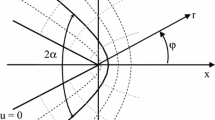Abstract
Narrow notches often cause damage that can lead to the destruction of components. The stress field in the vicinity of such crack-like notches in two-dimensional (2D) structures is similar to the stress field around equivalent cracks. Therefore similar investigations are necessary to predict the fracture load for components with cracks or narrow notches. Thus, the asymptotical stress field for a narrow notch with a rounded notch root is deduced from an Airy’s stress function. Based on this stress field a fracture criterion is developed. Comparing the theoretical fracture limit curves derived from the fracture criterion with experimental results it can be shown that for brittle material the local stress state at the fracture initiation point is the same for mode I, mixed-mode and mode II loading.
Similar content being viewed by others

References
Peterson R.E. (1974) Stress Concentration Factors. Wiley, New York
Bart J., Neuber H., Schnack E. (1976) Kerbfaktordiagramme nach numerischen Berechnungsverfahren. Konstruktion 28, 217–218
Irwin G.R. (1957) Analysis of stresses and strains near the end of a crack traversing a plate. J. Appl. Mech. 24, 361–364
Barth F.J. (1991) Berechnung theoretischer Rißwiderstandskurven auf der Basis des asymptotischen Rißwachstumsfeldes. Dissertation, University of Kaiserslautern
Williams M.L. (1952) Stress singularities resulting from various boundary conditions in angular corners of plates in extension. J. Appl. Mech. 19, 526–528
Williams M.L. (1957) On the stress distribution at the base of a stationary crack. J. Appl. Mech. 24, 109–114
Creager, M: The elastic field near the tip of a blunt crack. Master’s Thesis, Lehigh University (1966)
Creager M., Paris P.C. (1967) Elastic field equations for blunt cracks with reference to stress corrosion cracking. Int. J. Fract. Mech. 3, 247–252
Kullmer, G.: Elastische Spannungsfelder an einer ausgerundeten scharfen Kerbe. In: Vorträge zum Problemseminar Bruchmechanik V – Werkstoffmechanik, Heft 2/91, Weiterbildungszentrum für Festkörpermechanik der TU-Dresden, Dresden, pp. 76–88 (1991)
Kullmer, G.: Tragfähigkeitsvorhersage für Bauteile mit Kerben und Rissen. Fortschritt-Berichte VDI, Reihe 18: Mechanik / Bruchmechanik, no. 152, VDI-Verlag, Düsseldorf (1994)
Richard, H.A.: Bruchvorhersagen bei überlagerter Normal- und Schubbeanspruchung von Rissen. VDI-Forschungsheft 631, Düsseldorf (1985)
Neuber H. (1985) Kerbspannungslehre. Springer, Berlin Heidelberg New York
Ritchie R.O., Knott J.F., Rice J.R. (1973) On the relationship between critical tensile stress and fracture toughness in mild steel. J. Mech. Phys. Solids 21, 395–410
Neuber H. (1968) Über die Berücksichtigung der Spannungskonzentration bei Festigkeitsberechnungen. Konstruktion 20, 245–251
Erdogan F., Sih G.C. (1963) On the crack extension in plates under plane loading and transverse shear. J. Basic Eng. 85, 519–525
Author information
Authors and Affiliations
Corresponding author
Rights and permissions
About this article
Cite this article
Kullmer, G., Richard, H.A. Influence of the root radius of crack-like notches on the fracture load of brittle components. Arch Appl Mech 76, 711–723 (2006). https://doi.org/10.1007/s00419-006-0089-6
Received:
Accepted:
Published:
Issue Date:
DOI: https://doi.org/10.1007/s00419-006-0089-6


